Adapting Stephen King's Graveyard Shift: The 1990 Rat Fest Is The Textbook Definition Of A 'Bad Stephen King Movie'
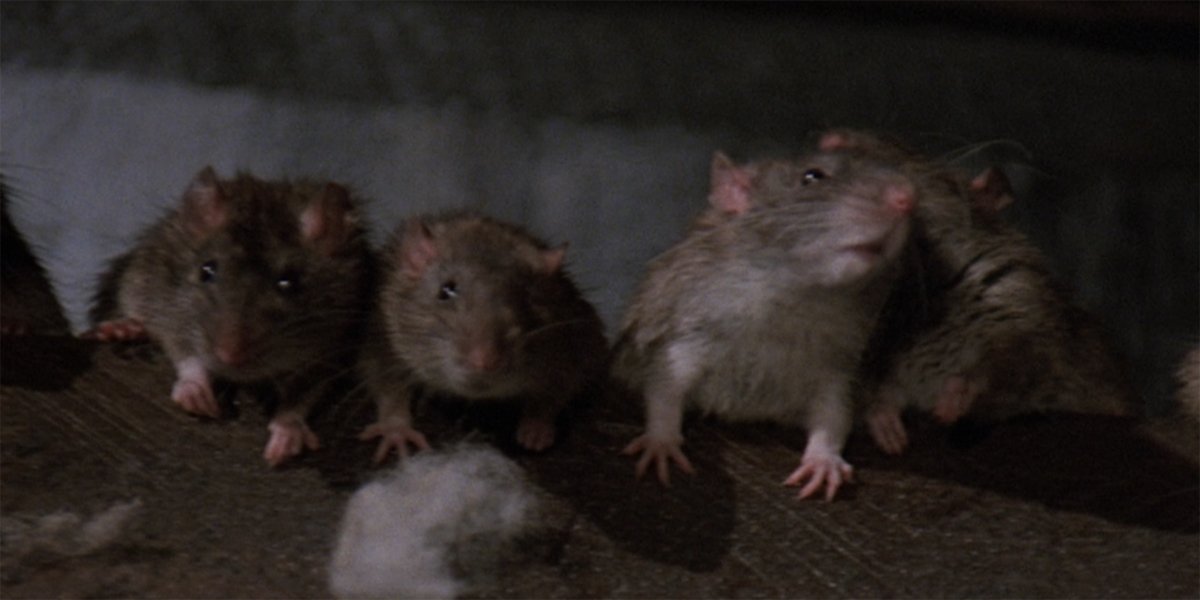
“Graveyard Shift” is a work with a pretty important legacy in the Stephen King canon. While The Long Walk was the first novel he ever wrote, and Carrie was the first novel that he got published, “Graveyard Shift” was the first short story he was able to sell to a mass market publication for a real payday. King had graduated from the University of Maine in 1970, and by October of the same year the rat-centric prose was printed in an issue of Cavalier magazine, earning him compensation of $200. It was a monumental event for King in his early career hoping to become a professional writer, and, as noted in Douglas E. Winter’s Stephen King: The Art Of Darkness, it also began his relationship with editor Nye Willden (whose name you may remember from last week’s column about Tales From The Darkside: The Movie).
The short story’s pop culture history didn’t come to an end there, however. In 1978 it was given prime positioning in Stephen King’s first published collection, appearing as the second entry in Night Shift. Oh, and in 1990 it was turned into one of the worst King adaptations to date.
Director Ralph S. Singleton was first approached about making Graveyard Shift into a film on the set of Mary Lambert’s Pet Sematary (on which he worked as an associate producer), but he didn’t actually act on it until production on the 1989 movie was completed. When he finally got around to reading the short story, he was sparked to its potential, and then made moves to get it made as quickly as possible. Singleton discovered a pre-existing, unauthorized script by a first time screenwriter named John Esposito, and in April 1990 he sold the idea to Paramount with the promise that they would be able to release the latest big screen Stephen King adaptation in time for Halloween.
It was a deadline that the production was able to hit… but there’s also a very good reason why most movies are made with more than a six month production schedule to work with.
Clearly I am not a fan of the film, but as a King adaptation it has all rights to be a subject of discussion in this column – and it is nonetheless still interesting to look at the history of the short story, discuss how the movie compares to the source material, and critique it more than 30 years after its original release. So let’s dive into Graveyard Shift for the twentieth edition of Adapting Stephen King.
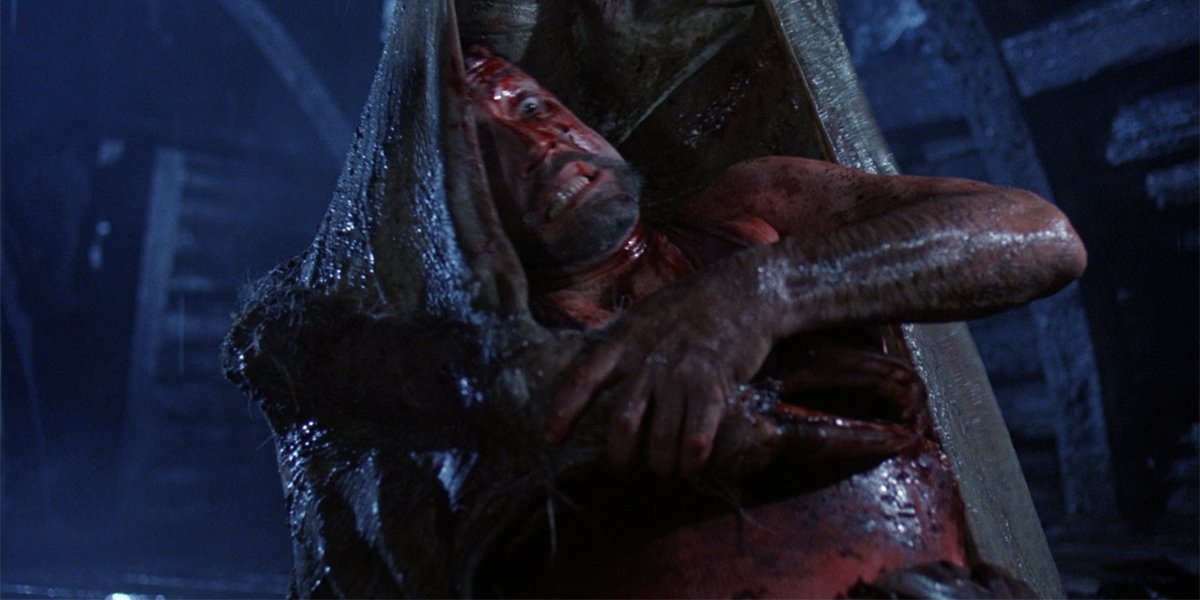
What Graveyard Shift Is About
Given the significance of “Graveyard Shift” in the early years of Stephen King’s career, it should come of little surprise that the origins of the short story come from the author’s youth. When King was a teenager, he got a job working as a dyer at Worumbo Mills And Weaving – a textile factory producing woolens in Lisbon Falls, Maine. It was hard work he did to make money as a poor high school and college student, but according to a colleague at the mill the gig could have been far worse.
Per Ian Nathan’s Stephen King At The Movies, King struck up a relationship with a veteran at the establishment who told him horror stories about clean-up operations in the building’s basement. This duty would see employers not just encounter rats, but rats that were described to the writer as being as big as dogs. While it was probably just a tall tale, the idea was captivating enough for King to be inspired to pen a new short story.
Your Daily Blend of Entertainment News
Our protagonist in “Graveyard Shift” is Hall – a college-educated drifter who has spent his adulthood searching for his purpose, and certainly doesn’t find it working during the middle of the night in a brutally hot mill located in the town of Gates Falls, Maine. There are plenty of things to complain about, but chief among them is the looming presence of Warwick, his shift foreman.
Prior to the July 4th holiday, Warwick approaches Hall about pulling some extra duty, namely cleaning out the building’s basement, which has gone ignored for about 14 years. Needing money, and the opportunity coming with bonus pay, Hall agrees and becomes part of a 36-man crew, but none of them are prepared for what the work entails. In addition to removing various bulk items and hosing the place down, they are constantly set upon by rats that call the space their home.
As horrible as those rodents are, though, they are nothing compared to the horrors awaiting Hall and Warwick in the secret subbasement that the workers discover days into the job.
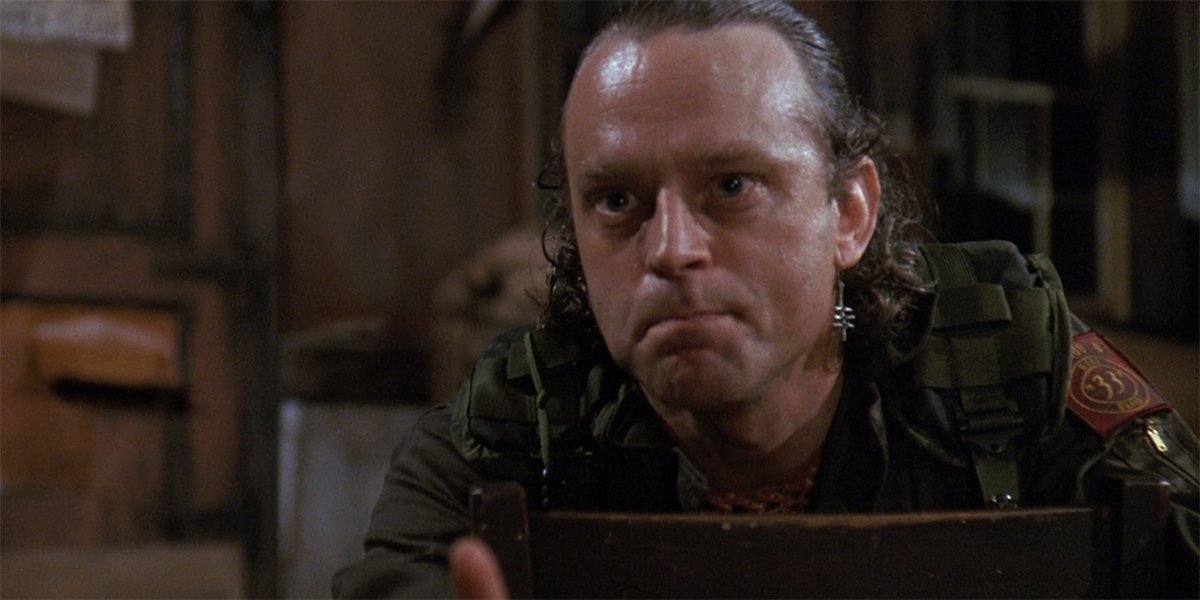
How Ralph S. Singleton’s Graveyard Shift Differs From Stephen King’s Short Story
Being just a little over 86 minutes long, Ralph S. Singleton’s Graveyard Shift is the second shortest movie based on a published Stephen King work – but even with that being the case the film still needed to expand on the source material. After all, the short is only 18 pages long as printed in the first edition hardcover of Night Shift, and if it were to be directly translated scene-for-scene it would probably result in a 20-minute short film rather than a full feature.
One of the biggest changes is the impetus for the whole plot. Rather than having the cleanup duty in the basement simply be overdue maintenance, the film changes things so that they are a bit more shady, with Warwick (Stephen Macht) putting the gig together only when pressured by the U.S. Department of Labor following the death of an employee (said death also being an original invention for the adaptation). The subject of zoning laws and protocols are brought up in the short story, but only after the crew discovers that the subbasement is practically overflowing with vermin, and Hall (David Andrews) uses knowledge of the law to basically blackmail Warwick into exploring the dank and mysterious space with him.
The custodial coalition in the movie is far smaller, featuring only six employees plus Warwick, though the film does use some of the same character names, including Ippeston (Robert Alan Beuth) and Wisconsky (Kelly Wolf) – though Wisconsky as written by Stephen King is a male co-worker Hall dislikes due to his constant whinging. The adaptation also at the very least makes an effort to showcase the lives of those in the ensemble beyond their job, as all of the scenes outside of the mill come from John Esposito’s imagination.
All of the characters who aren’t mill employees are also original creations, and this includes Brad Dourif’s role, identified in the credits as The Exterminator. One of the very limited number of highlights in Graveyard Shift is the scene where he explains how rats were used to torture prisoners of the Viet Cong during the Vietnam War, and it’s a case where credit doesn’t extend back to the original author.
The greatest change of all in “Graveyard Shift” going to the big screen is the monster that is featured in the movie. In Stephen King’s short story, Hall and Warwick are horrified to discover what appears to be a whole new evolutionary chain of rodents in the subbasement, as the creatures are not only massive in size, but also horrendously mutated. They eventually discover what they identify as the nest’s queen (or “magna mater”), which is a grey, eyeless, legless rat the size of a Holstein calf, but by the time they make that discovery, they are too deep into the swarm and both men are devoured.
The film abandons all of that creativity, and simplifies the hell out of it. Instead of creating an escalating nightmare where the characters discover bigger and more evolved creatures as they continue their clean-up work, there is instead just one single horror terrorizing the mill, and it’s a man-sized bat creature that somehow has no issue making its way around all levels of the factory.
That just leaves us with the different endings, which notably feature radically different tones. The final lines of Stephen King’s story are haunting, as it is revealed that the rest of the janitorial volunteers have no idea what happened to Hall and Warwick, and plan to venture into the subbasement after them. The film just aims for and executes the cliché Hollywood conclusion, which sees Hall grind up the bat-like monstrosity in a cotton picker in a sequence that feels like a blatant Jaws rip off.
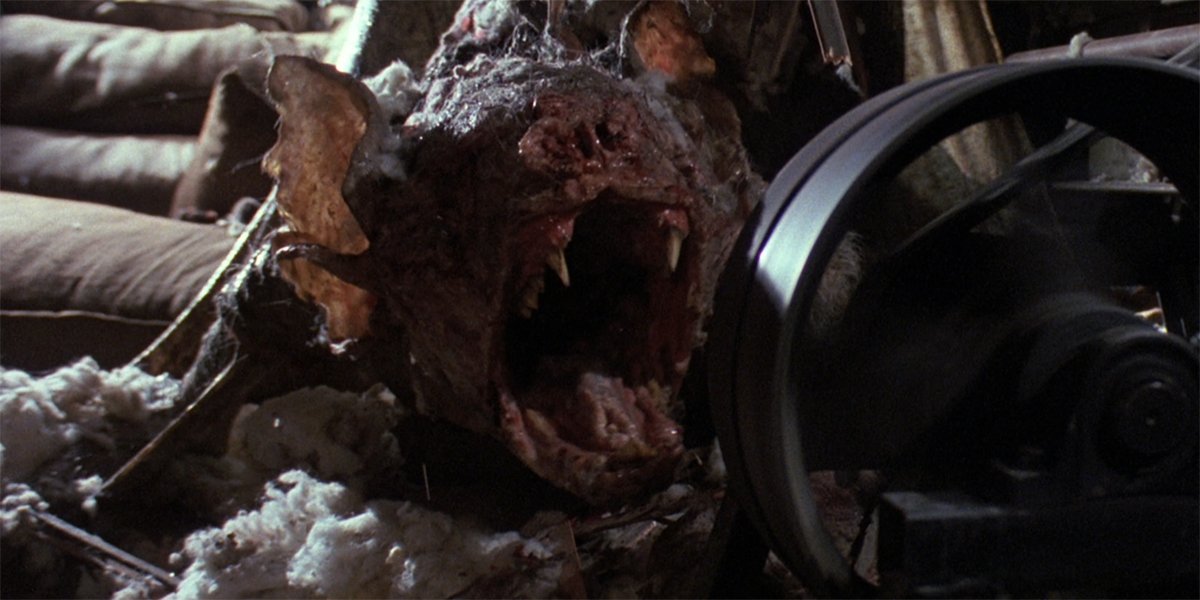
Is It Worthy Of The King?
The popularity of Stephen King has obviously long been a motivating factor behind so many of his works being brought to life by Hollywood (hence the Richard Bachman experiment), but that reality takes on a different color when refracted through Ralph S. Singleton’s Graveyard Shift. In short, it is the first adaptation that doesn’t feel like it was made with real passion or appreciation for the source material. Instead, its raison d'etre was a hollow attempt to take advantage of the heat that King’s name had following the blockbuster success of Mary Lambert’s Pet Sematary, and that’s an energy that continues to permeate through the film more than three decades after it first hit the big screen.
Graveyard Shift was actually shot on location in Maine, fulfilling a stipulation provided by the author before he gave his blessing to the project, but there is very little beyond the setting of the movie that could be described as “Stephen King-esque” – save for the performance by Stephen Macht. The actor not only sports a wonderfully thick local accent, but his smarmy attitude and horrible values effectively bring Warwick to life as he is presented on the page. Sadly, little else about the production, including the rest of the ensemble and the tepid, typical monster narrative, reflects the original work.
David Andrews’ Hall is a personality-less bore, and while I have an appreciation for Brad Dourif’s performance in Graveyard Shift, I’m not sure how anyone could say that the movie doesn’t totally waste the character (I will never cease to be confused by the fact that he is a character named The Exterminator, but rather than getting a vermin-centric death he gets killed when a coffin in a mausoleum crushes his skull). The adaptation is unable to capture the creepy crawly horror of the short story, or the dinginess, or the madness.
As you can probably guess, it’s not a film that is deeply appreciated by Stephen King. In fact, when King was asked to identify his least favorite adaptation in a 2016 interview, the author was initially hesitant to answer, but ultimately the first title that escaped his lips was Graveyard Shift. He told Deadline,
Should I even say that? I guess there are a number of pictures that I feel like, a little bit like, yuck. There’s one, Graveyard Shift, that was made in the eighties. Just kind of a quick exploitation picture.
He technically got the decade wrong, but the sentiment is spot on: it is an exploitation picture, and what's being exploited is the author's name. While there are many filmmakers who directly express their love for Stephen King through their adaptations, the legacy of 1990’s Graveyard Shift is as a shoddy cash grab.
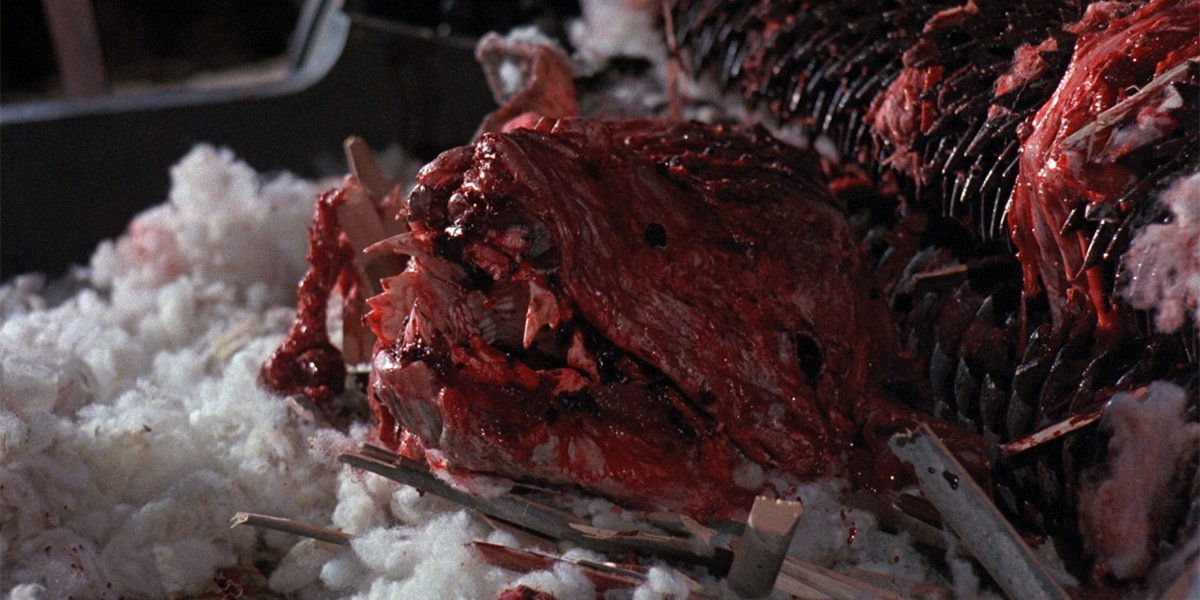
How To Watch Ralph S. Singleton’s Graveyard Shift
While I can’t imagine that this feature would inspire anyone to be excited to watch Graveyard Shift, if you have a desire to now judge it for yourself the opportunity is widely available. The film is not presently on any streaming service, but it can be rented or purchased digitally at all major online retailers (including Google Play, Amazon Prime, and Vudu). If you’re a physical media collector trying to build the ultimate Stephen King collection, your best option is the Scream Factory Blu-ray that was released in 2020 and features a number of original special features.
Coming up, Adapting Stephen King will once again shift back to the CinemaBlend TV section, but this time it will be for what is arguably the most beloved miniseries adaptation of the King canon: Tommy Lee Wallace’s two-parter IT from 1990. Look for it here on the site next week, and in the meantime you can scroll down and click through the banners below to discover all of the previous installments of this column.







Eric Eisenberg is the Assistant Managing Editor at CinemaBlend. After graduating Boston University and earning a bachelor’s degree in journalism, he took a part-time job as a staff writer for CinemaBlend, and after six months was offered the opportunity to move to Los Angeles and take on a newly created West Coast Editor position. Over a decade later, he's continuing to advance his interests and expertise. In addition to conducting filmmaker interviews and contributing to the news and feature content of the site, Eric also oversees the Movie Reviews section, writes the the weekend box office report (published Sundays), and is the site's resident Stephen King expert. He has two King-related columns.
